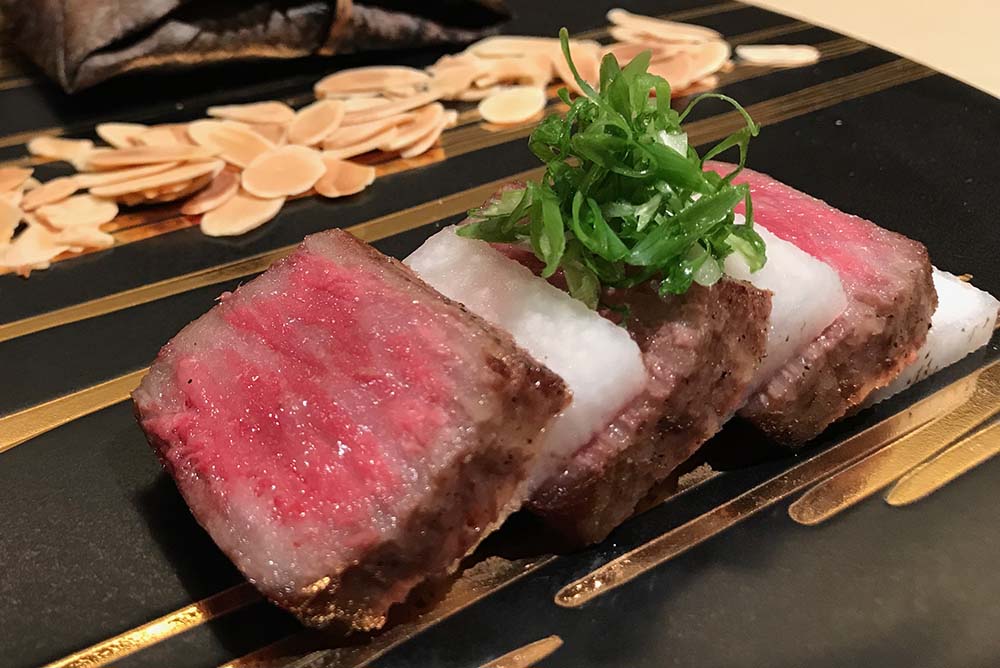Adam Waxman is an award winning travel journalist focusing on…
Recently I read “Wagyu Carpaccio” on a restaurant menu. I asked the waitress, rhetorically, cynically, “Where is this Wagyu from?” After checking with the kitchen she returned to tell me, “Canada.” Really? If I were to ask where the Chianti is from, would she have said anywhere other than Chianti? I hope not. Chianti is from Chianti. That’s why it’s called “Chianti.” Similarly, Wagyu is from Japan. That’s why it’s called Wagyu. Wa refers to Japan. Gyu refers to cattle. Strictly speaking, you cannot produce Wagyu outside Japan. While there are many countries, namely the US, Australia and Canada, that claim to produce “wagyu” beef. They should be labeling it “Wagyu-style”, “American Wagyu”, “Australian Wagyu”, “Canadian Wagyu” or “Washugyu”, which is a cross breeding of Wagyu and Angus. If the beef is descendent of Japanese cattle, raised outside Japan, or crossbred outside Japan, and not sourced directly from Japan, it’s not wagyu. In fact, most Japanese cattle in Japan are cross-bred, but the difference between beef in Japan, and Japanese beef or some derivative of it in, say, Canada, is night and day. From water, to climate, to feed, to care, it’s just different. Anyone who has tasted wagyu beef in Japan can attest to that.
Branding:
Angus beef is originally from Scotland, but Angus is a brand. In order to be labeled Angus, the beef need only be 21% true Angus. Wagyu, however, is not a brand. It is akin–though not officially–to a designation of origin. It would be as strange as a farmer in Japan claiming to be raising Canada Beef. In Canada, the percentage of wagyu in cattle can be as high as 75%, but there is a hefty price tag for that. If you see “Kobe Beef Burgers” or “Wagyu Beef Burgers” on a menu or at a supermarket, and it costs less than $100 (typically $15-$20), it’s simply false marketing. There are over 100 brands of wagyu in Japan, and none of them will make it into a Canadian supermarket burger. Typically, each prefecture in Japan boasts it’s own brand of wagyu.

My top ten favourites:
1. Sanuki Olive-gyu, Kagawa (Gold medal winner at 2017 Wagyu Olympics)
2. Ishigaki-gyu, Okinawa
3. Matsuzaka-gyu, Mie
4. Hitachi-gyu, Ibaraki
5. Murakami-gyu, Niigata
6. Shinshu-gyu, Nagano
7. Noto-gyu, Ishikawa
8. Olean 55, Tottori (First Wagyu Olympics gold medal winner)
9. Kobe-gyu, Hyogo
10. Ohmi-gyu, Shiga
Wagyu or Kobe?
Kobe is a port city located in Hyogo Prefecture in which there are also several other brands of beef including: Sanda, Sanga and Tajima. “Kobe” is higher grade Tajima (A4 or A5.) Historically most beef would be exported from the port of Kobe, so that regardless of its origin, it would be stamped “Kobe.” That is how the name originally gained its renown. Today there are very strict rules around the raising and harvesting of beef in Hyogo-Ken in order to allow it to be classified as Kobe Beef. Make no mistake, it is exquisite, but other than select restaurants in Kyoto, Osaka or Tokyo, you’d be hard-pressed to find it outside Kobe. Increasingly, there are restaurants from Las Vegas to Miami to New York and occasionally Toronto who may have access to serve some Kobe beef, but the kitchen will have a certificate of authenticity with the nose-print of the cow for certification.

At a Michelin star restaurant in Napa Valley, I read “Kobe beef” on the menu. I was doubtful, so I asked, “Where is this “Kobe” beef from?” The waitress returned with the official certificate from Japan including designation of origin. I was impressed, but, the certificate clearly stated “Miyazaki”–a totally different area of Japan. It would be like calling “Swiss” chocolate “Belgian”–both wonderful, but not the same. There is this misconception that Kobe and Wagyu are synonymous. They are not. Kobe is a city. Wagyu is a style of beef. Kobe is the name of one brand of Wagyu. The two are not interchangeable. This was indeed wagyu, and it was delicious, but it was Miyazaki-gyu, not Kobe.
So what’s the big deal about Japanese beef anyway? It is not as robust as Canada Beef, not as juicy as USDA Prime, not as succulent as the Pampas grass-fed Argentina Beef, but its texture is so soft and delicate that it is often compared to foie gras. While USDA prime beef requires 6-8% marbled fat to qualify for the highest USDA grade, the highest quality grade for Wagyu typically has 25% marbled fat. It is this mono-saturated interstitial fat (the good kind), called “sashi”, that makes wagyu the prize of Japan.
Grading:
There is a strict grading system for wagyu beef in Japan. The Yield Grade refers to the proportion of meat obtained from the cut of the cattle.
A: above standard
B: standard
C: below standard
The Beef Marbling Standard ranks the interstitial fat content. The more marbling, the higher the number.
5: Excellent 8 – 12
4: Good 5 – 7
3: Average 3 – 4
2: Below average 2
1: Poor 1

When in Japan, the most desired wagyu is graded A5. If you have ¥10,000 to spare, or more, skip the sushi and sample this unique and sublime delicacy.
Read more:
Adam Waxman is an award winning travel journalist focusing on food, wine and well being. As well as an actor in film, television and formerly, the Stratford Festival, he is the Publisher of DINE and Destinations magazine.




